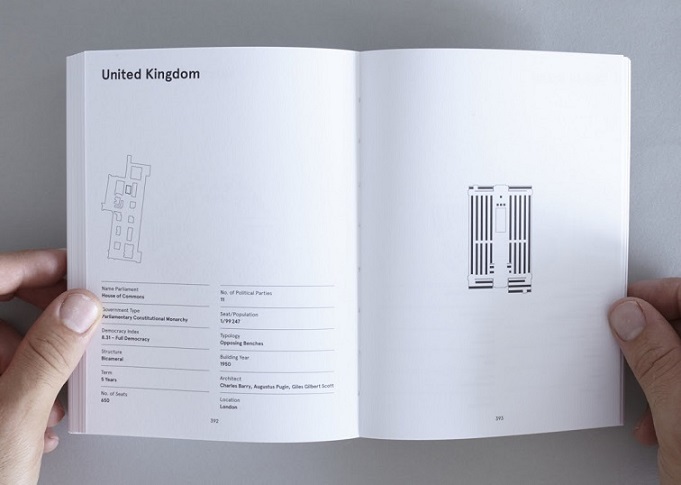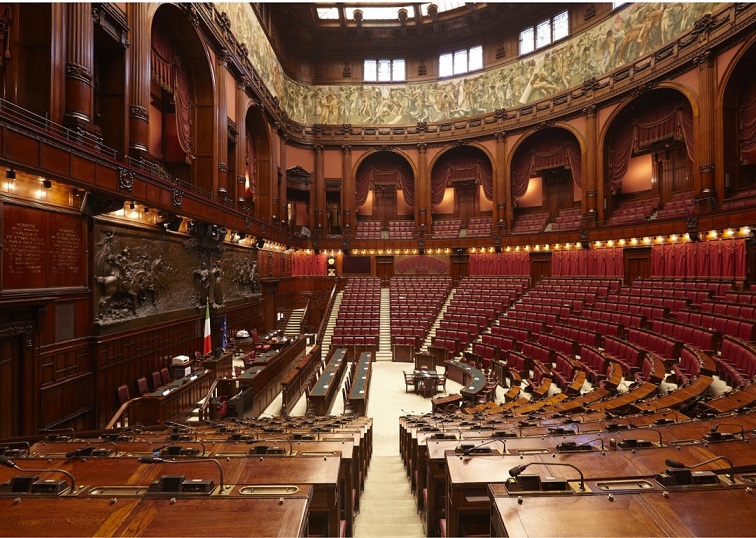What they found is that all the plans adhere to one of five basic setups: benches opposing each other in two sets of lines; a semicircle; a horseshoe; a circle; or a classroom-like layout, where politicians are rigidly oriented to face the front of a room. While many European national parliaments have opted for the semicircular layout — indicative of a “consensus-seeking” room, XML says — it’s mostly authoritarian countries that have adopted the classroom setup, from Cuba to China to North Korea. Only 11 nations, including Uzbekistan, Lesotho, and Slovenia, have chosen the circle, which the firm says is the youngest form and a “representation of democratic equality.”
XML has published these findings in a very handy and beautifully designed manual, Parliament, available through Idea Books. It’s the first tome to provide an overview of parliaments around the world that allows you to easily compare their plans. The book is laid out like a directory: each entry features a simple diagram by XML, along with data such as the room’s number of seats, the nation’s government type, and its democracy index. In the back are indexes that organize the parliaments in a variety of informative ways, such as by building year or by seat-to-population ratio. Thumbing through the pages reveals trends, most notably that the same five architectural foundations have persisted over time, even as our political systems have transformed considerably.
“The book reveals a systemic lack of innovation in the architecture of spaces of political congregation,” XML’s partners told Hyperallergic. “Most of today’s parliaments were created in the 19th century and have hardly changed ever since. At a time in which democracy is under pressure in many parts of the world, we hope the book helps to rethink the architecture of assembly.”
The system of opposing benches, they explain in Parliament, comes from the medieval royal court of England, when the seats originally revolved around the monarch but were organized to fit the nave of St. Stephen’s Chapel. The House of Commons still uses the setup of long rows, but notably, so too do the assemblies of many former British colonies, from Singapore to Zimbabwe. Later on, the semicircle — whose form reflects Greek and Roman theaters — proved popular in 19th-century Europe, during a period of nation building and Neoclassical fever. As XML explains, new states used the shape “to foster consensus among a representative elite,” which is surely an outdated mission today.
 Plan of the House of Commons, United Kingdom
Plan of the House of Commons, United Kingdom
XML also traveled to some of these meeting halls to create a more immersive counterpart to Parliament. Visiting 15 spaces, including parliament chambers in Japan, Botswana, Brazil, and Germany, they photographed the interiors to create a series of 360˚ panoramas. All of them are online, allowing you to explore a specific hall and observe it from different positions of power. Some of the buildings are Modernist masterpieces, such as the Bangladesh’s Jatiyo Shangshad, designed by Louis Kahn; Brazil’s Câmara dos Deputados, designed by Oscar Niemeyer; and India’s Punjab Vidhan Sabha, designed by Le Corbusier.
 Plan of Jatiyo Sangshad, Bangladesh
Plan of Jatiyo Sangshad, Bangladesh
 Jatiyo Sangshad in Bangladesh, designed by Louis Kahn (photo by XML)
Jatiyo Sangshad in Bangladesh, designed by Louis Kahn (photo by XML)
So what should a parliament for the 21st century look like? Parliament doesn’t provide a solution, although it argues that these spaces need innovative updates. But last year, XML had a chance to experiment with a new form, when the Dutch Ministry of Foreign Affairs commissioned the firm to design a meeting room in Brussels for European government leaders. The result combines opposing benches with a semicircle through a series of interlocking, powder blue blocks that allow for fluid seating.
“In our design, government leaders can change positions between group settings or bilateral talks, and can choose sides on opposing benches or have a dialogue in a more informal setting,” XML told Hyperallergic. “Other than the fixed seating in most parliaments, our design is a more dynamic space that invites different ways of use, depending on the sort of meeting.”
According to the firm, parliaments in Austria, the Netherlands, Norway, and the UK are all currently preparing to, or in the process of, renovating their spaces. Even if they don’t undertake total overhauls, the renovation period offers an important opportunity to begin to develop new spaces that better reflect today’s political dynamics.
 XML’s design for the European Council presidential chambers last year
XML’s design for the European Council presidential chambers last year Plan of Tweede Kamer, Netherlands
Plan of Tweede Kamer, Netherlands Plan of the Great Hall of the People, China
Plan of the Great Hall of the People, China Plan of the House of Representatives, United States
Plan of the House of Representatives, United States Câmara dos Deputados in Brazil, designed by Oscar Niemeyer (photo by XML)
Câmara dos Deputados in Brazil, designed by Oscar Niemeyer (photo by XML) Regional parliament of Punjab in Chandigarh, designed by Le Corbusier (photo by XML)
Regional parliament of Punjab in Chandigarh, designed by Le Corbusier (photo by XML) Camera dei Deputati in Italy, designed by Ernesto Basile (photo by XML)
Camera dei Deputati in Italy, designed by Ernesto Basile (photo by XML)












